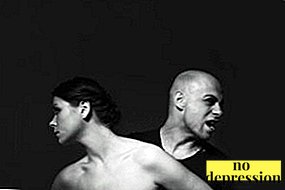In the course of their life every person actively interacts with society, and therefore occupies some place in it.
This situation is called social status. Consider this phenomenon in more detail.
The concept and characteristics

What is the social status of the individual?
Social status - this is the position taken by the individual in society, as well as what functions he carries with respect to the systems and groups to which he belongs to one degree or another and which rights he has.
This concept is used to characterize how an individual interacts with various groups and what place they occupy, as well as what social connections prevail in him.
For clarity, consider a student. His social status in the class suggests:
- duties - actions that need to be carried out in the community (class), communication (learning process), the system (secondary school), for example, regular attendance at classes, respect for classmates, homework, etc .;
- the rights - actions that other people perform in relation to the student, for example, a highly organized learning process, the presence of competent teachers, well-chosen literature, etc.
My social status - what is it?
The same person has several social statuses, both at the same time and throughout his entire life activity. For example, woman, mother, teacher, chess player, etc.
In this case, the subject can be characterized not only in terms of the individual characteristics of the person himself, but also based on the group he is in. Thus, the following levels can be distinguished:
- Private. In this case, it means a position in a certain small group (this includes family, student group, etc.). It is characterized by individual qualities and directly depends on how the other members of the group perceive the individual.
- Social group. This refers to a position in society, that is, a large group (here you can call race, gender, religion, profession, etc.). Characterized by the position of this group in the hierarchy of society.

The main characteristics of social status are authority and prestige, that is, recognition of the merits of the individual.
Views and examples
In general, there are a lot of varieties, therefore it is better to present it as the following classification:
- Prescribed. This includes biological characteristics specified (for example, gender, nationality, age). That is, his man receives, regardless of the desire and effort. The main difference is that they can not be selected and they can not be adjusted throughout life. To some extent, the prescribed status even determine the behavior of a person, his worldview.
- Acquired. His individual receives as a result of some events, but not by personal will (for example, grandmother, father-in-law, brother, mother-in-law, etc.). That is, for this he does not make any effort.
- Reached. Is a kind of purchased. The main distinguishing feature is that it is obtained as a result of conscious aspiration and invested effort. To a large extent, this type reflects professional categories (director, psychologist, doctor of science, teacher, professor, etc.). To raise or lower this species, it is necessary to react in a timely manner and change its behavior in accordance with the situation.
- Main. Most often, in this case, the profession of a person is considered, due to the fact that he is of great importance, has a direct impact on his capabilities and environment. You also need to focus on the characteristics of the cultural environment of a person and the surrounding reality.
For example, in countries with a patriarchal system for women, gender is the main status.
- Secondary. This includes the fact that a person can change several times a season or even a day. Most often differ insignificance for him. An example would be a buyer in a store, a spectator in a theater, a tram passenger.


There is another classification, which is no less important and stands apart from the above. Sociologists distinguish such species as:
- Tall. This is a good position in a society that is valued by a social group. In today's world, high status meets the following requirements: the availability of property, citizenship in a developed or developing country, higher education, a good level of stable income, financial reserves. Most often also characterized by connections with reputable people and power.
- Low. In this case, the position of a person in society is insignificant; this is realized both as a person and a social group. As a rule, this includes the absence of any property and place of residence, lack of education or its low level, low income or unemployment.
Most often, this also includes people who violate the law or have obvious problems with alcohol and drugs.
What are the three social status considered congenital? Congenital You can only name the following three prescribed statuses:
- floor;
- race;
- nationality.

For example, Asian - characterizes the race.
Woman - reflects the gender of a person.
Russian - determines the nationality.
All the listed categories are set biologically, a person cannot choose or correct them, inherits them not at will.
Social role criteria
What is the social role of the personality and what criteria should it meet? Under the social role understand specific model or pattern of behavior of an individual, which must meet a number of norms, as well as the expectations of society.
These are certain actions that must be performed by an individual according to his place in society.
We have a general idea of each social status, that is, what actions a particular person should perform.

For example, society expects that doctor will perform in relation to the patient actions that will help the latter to get rid of his illness.
Student will attend couples, write the necessary studies and pass the session.
Mechanic check the machine for faults and, if necessary, will be able to eliminate them.
If an individual for any reason does not fulfill the role assigned to him by his status and does not meet the expectations that society imposes on him, then various sanctions can be applied to it.
For example, the manager may be fined for failure to fulfill the sales plan, the director is dismissed due to negligence, the student is dismissed for failure to perform, the parents are deprived of parental rights due to oversight for the child.
It should also be noted that there is the concept of role conflicts - this is when the interests of several roles collide.
For example, a woman has the social status of his wife, mother, and head of the finance department. In this case, it becomes It is difficult to fulfill all the roles assigned to it.

In this case, the choice is left to the person, it is up to him who is left with the decision, as follows prioritize.
So, in the above example, a woman can hire a nanny or quit her job.
Her choices are largely determined by personal values. priorities and circumstances.
If she prioritizes career values, the remaining roles will have less meaning for her.
There are the following social role criteria:
- compliance with sociocultural expectations of society;
- functional expediency.
These criteria have a certain relationship, but in some cases they may be equivalent, and in others there will be an explicit selection of this criterion over the other.
For example, in a constitutional monarchy, the king’s activities do not have special significance in terms of functionality, his role is more likely sociocultural significancebacked by the traditions of society.

The role of the police in our time is estimated primarily from its functionswhich she performs.
If we talk about the equivalence of the criteria of the role, then the example can be the President of the Russian Federation, who has functional and sociocultural significance.
Thus, a person performs many roles for the realization of their social status.
On this basis, the individual can be considered as complex systemwhich combines both statuses and roles.
Social status - concept, types, examples:



